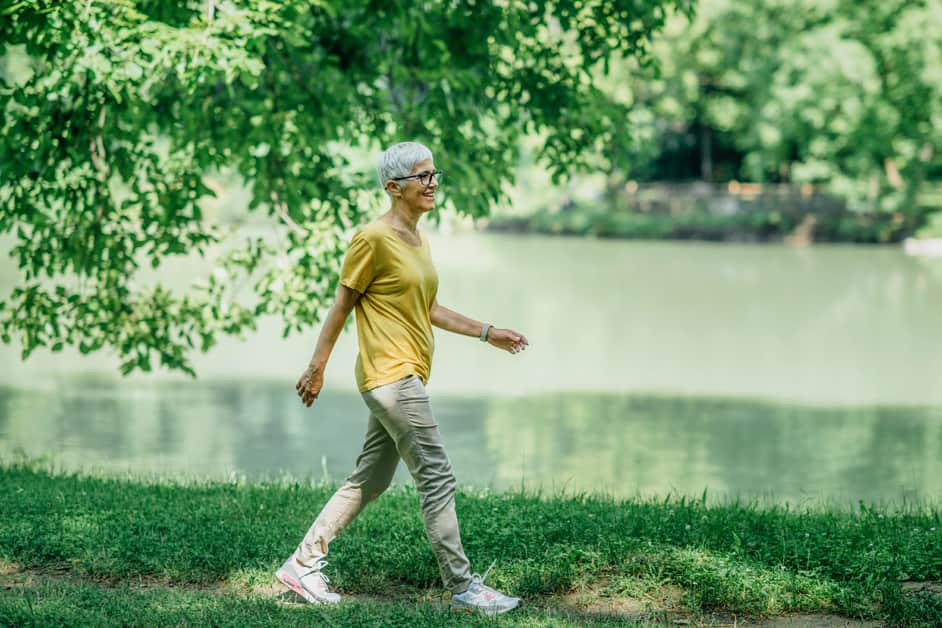Introduction
Walking is an awesome exercise! It is low-impact, yet still gives your body lots of benefits. Studies prove that it can reduce knee arthritis and joint pain by up to 24%. Plus, no special skills or equipment are needed. You can do it at your own pace, and even increase speed and distance as you get used to it.
There are other great benefits too – it helps with your heart health, losing weight and toning muscles. You can enjoy it anywhere – sidewalk, trail, neighbourhood or treadmill. Taking a daily stroll is a great way to be active and stay healthy.
For those who are at risk of knee problems due to age or genetics, walking is even more important. It strengthens muscles around the knees and increases joint flexibility. That helps reduce stiffness and discomfort.
Benefits of Walking
Walk it off! Strolls are an awesome, low-impact type of exercise. They have many health perks. For instance, they can help avoid knee injuries. Research suggests that walking can reduce inflammation in the knees, increase joint mobility, and even slow down the development of osteoarthritis.
Let’s explore how walking can benefit your health and protect you from knee injuries:
Low-Impact Exercise
Walking has many benefits, not just physical. It’s low-impact and can reduce stress, lift moods and stop knee injuries. The movement is gentle on joints and bones, making it a great choice for those with joint pain or arthritis.
It also gets your blood flowing, warming up muscles and prepping them for running and aerobics. Plus, walking outdoors brings vitamin D, fresh air and mental clarity.
For those with knee problems like osteoarthritis and bursitis, walking is an effective, safe exercise. It releases endorphins that lessen pain and inflammation.
- Plus, it builds leg strength, stabilises joints and prevents injuries.
- Proper back alignment can improve posture and balance, flexibility and range of motion in hip and knee joints.
Strengthens Joints
Strolling is a low-impact exercise that can help boost joint mobility and flexibility without putting too much strain on the joints. Studies have shown that regular walking can reinforce the muscles and ligaments around the knee joint, giving important support to stop knee injuries. It also boosts blood circulation to the area, which increases oxygen and nutrients for the tissue.
Moreover, walking strengthens muscles in other parts of the body, like the hips, thighs, calves and glutes. This aids in proper posture and keeping good alignment for healthier knees.
Plus, its repetitive motion is in sync with the motion of your lower body joints. This stimulates the production of synovial fluid, which keeps your joints lubricated for better shock absorption during daily activities.
To conclude, walking is one of the most beneficial exercises that has proven advantages for strengthening your joints around your knee area.
Improves Blood Circulation
Walking is great for your circulation. It helps regulate your metabolism and gets oxygen-filled blood to your organs, spine, and muscles. Plus, this can reduce your risk of certain diseases like heart attack and stroke.
Take 30 minutes to walk every day – your cardiovascular health will thank you! This boosts your heart’s strength, so it doesn’t have to work as hard. Plus, it can reduce the risk of abnormal heart rhythms.
It can also reduce pain and swelling in your legs. The movement of toxins through your muscles will give you energy throughout the day. So, walking is great for your circulation!
How to Prevent Knee Injuries
Struttin’ your stuff is a great way to stay fit. No matter your age or level of fitness, it can help strengthen your knees, boost your balance, and reduce joint pressure.
This article will check out the perks of taking a stroll for knee health and give tips on how to stop and manage knee injuries:
Warm Up Before Walking
Before walking, warming up is super important – it can help you with physical and mental performance. Plus, it protects your joints. Do a few dynamic stretches for 5 minutes to increase range of motion and get blood circulating. You can do slow leg swings, butt kicks or march on the spot.
Foam rolling with a trigger point foam roller is also great. It helps break up scar tissue. Move slowly and use proper form, then increase effort and speed as needed.
Don’t forget to cool down after walking with dynamic stretches. Hold each stretch for 10 seconds to relax your muscles!
Wear Proper Footwear
Wearing a supportive shoe for walking is key to reducing knee injury risk. Look for shoes with cushioning, arch support, and stability – these help absorb shock. Get shoes with a wider sole to spread that shock. Properly fitted shoes are essential. Make sure they’re the right size and width – not too squashed or too big. Flawed fit can change posture and stress your knees.
Replace running shoes every 300-400 miles or when worn out – this helps shock absorption and decreases injury risk.
Increase Intensity Gradually
Always build up your exercise routine gradually. Too much intensity can cause joint pain and hurt your knees. Warm up before any activity – walking, jogging, cycling – by stretching the lower leg muscles and tendons. This helps maintain good form and keep joints in alignment.
Start slow. Increase intensity gradually, focusing on proper form. Use elasticity in muscles and ligaments, not grinding on joints. Monitor your body as you move, adjusting if something doesn’t feel right.
Build your exercise routine over time, at a pace that works best for your body:
- Use elasticity in muscles and ligaments, not grinding on joints.
- Monitor your body as you move, adjusting if something doesn’t feel right.
- Increase intensity gradually, focusing on proper form.
Stretch After Walking
Stretch your legs after a walk for maximum benefits and to help prevent knee injuries. Stretching relaxes tension, improves joint movement and reduces pain. Do both dynamic and static stretching exercises for the best results.
- Dynamic stretches involve slow movements that stimulate blood flow and improve balance. Examples are leg kicks, leg swings and side lateral lunges.
- Static stretching, hold each pose for 10-30 seconds. These include butterfly poses, quadricep stretch, hip flexor standby routine and hip rotator muscle stretch.
For warmer up, do light activity like walking in place or marching. Drink water before, during and after exercise to stay hydrated and avoid straining muscles.
Conclusion
Walking is a fantastic way to exercise! It can improve your physical and mental health, as well as help with your posture and coordination. Plus, it helps reduce the risk of knee problems.
If you want to start walking or any other physical activity, talk to your doctor or physical therapist first. They’ll help ensure you’re using the right techniques and staying safe. Everyone can benefit from low-impact exercises like walking!
Frequently Asked Questions
Q1: What is walking?
A1: Walking is a low-impact exercise that involves putting one foot in front of the other at a steady pace. It is a form of aerobic exercise that can help to improve cardiovascular health and can help to prevent or reduce the risk of knee injuries.
Q2: How can walking help to prevent knee injuries?
A2: Walking is an excellent way to strengthen the muscles around the knee and to improve the range of motion. The impact of walking is much less than running or other high-impact activities, which means it puts less stress on the knee joints. Regular walking can help to reduce the risk of knee injuries and improve overall knee health.
Q3: How often should I walk for knee injury prevention?
A3: It is recommended that adults get at least 150 minutes of moderate-intensity aerobic activity such as walking every week. This can be broken down into 30 minutes of walking five times a week. However, the exact amount of walking needed for knee injury prevention will depend on the individual and their current fitness level.





